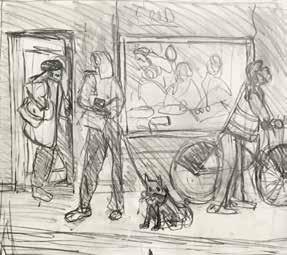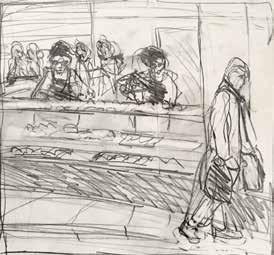

Simon
FEBRUARY 28 - MARCH 25, 2017
This catalog was produced in conjunction with:
Simon Carr
Scenes and Stories
February 28 – March 25, 2017
Bowery Gallery
530 West 25th Street
New York, NY 10001 www.bowerygallery.org
For Cristina
Special thanks also to Leonard Schwartz for permission to use his poem, to John Goodrich for the catalog design and photography of paintings, to the authors of the “Obvious Painting Manifesto,” to Lydia Carr at Anagram Editing, to C.B. Carr for photography of drawings, to Sam Carr for the gallery installation, to Ben Carr, Gabriela Carr and Michael Corey for their insights and advice, and to Malcolm Benjamin Carr Corey.
Front cover: Snow by the River 2015, acrylic on canvas, 50 x 75 in.
Opposite: Raven 2016, woodcut, 14 x 11 in.
from “Salamander: A Bestiary” by Simon Carr and Leonard Schwartz, ©2017 Chax Press

Amazingly A raven is seen In the Turbulent border Between Telos and boredom. Rain pounds That unmoving raven. Only when crows come Does the raven flinch —Leonard Schwartz
Simon Carr Scenes and Stories


Retrieving Vision
by Leonard Schwartz
A child raises its hand to point, gesture, or reach. This figure does not appear in all of Simon Carr’s recent paintings, compositions that are both scumbled and complexly colored, but it appears in some of them, and is a key to all of them, since it is suggestive of the persona of the painter—the painter, that creature entirely dependent on hand and eye, that wonder as primal and as refreshing as the child.
There are no eyes in these paintings, or at least very few of them, and then they are only suggested. The face, even, gives way to the largesse of the head and, I want to say, the palpability of the soul. Thus the subtle movements of a child’s hand—or a painter’s hand—become paramount.
The hand, like the eye, comes before language.
In “Snow Scene” the child’s confidently raised hand communicates with the golden retriever at a level below the adult and in a zone prior to language—to which the dog responds.
In “Bakery” the child reaches for the good things to eat, only to encounter a pane of glass.
New Bakery Window 2015, acrylic on canvas, 42 x 42 in.
To the extent all of Carr’s paintings encourage a certain incarnation theology, a certain immanence in form, a certain sense that ancient patterns are being enacted freshly, as if for the first time, these exchanges, as that between child and golden retriever or child and glass and bakery workers, are imbued with that of a secret recognition—to which other figures are blind, even as we might be blind to the sides of those figures lost in their own shadows or murk or depth.
Bakers, glass, and a child in blue; dog walkers, golden retriever, a child in green: in Carr’s paintings things don’t exist in themselves, they are created in the relations between them, bringing us to the threshold of narrative without ever resolving into some definite and limiting story, the mystery of the visible inviolate. The tangle of hand and leash, but also of invisible connections and pulls, creates a thicket of suggestion.
In his The Greeks and the Irrational the classicist E.R. Dodds wrote about “the partial vision of the living.” What we are blind to suggests something about the preciousness of the visible, while the potential for total blindness creates the sense of an actual visual unity, as if to say if it could all go away it must all now be here. These cross-currents of visible and invisible, light and blindness, ignorance and divinity, the peripheral and the central, illuminate and shadow each canvas. Town and country, horse riders and horses, the ever present golden retriever, bakery, hair salon and most of all dogs being walked along the Hudson River at the edge of the West Village by their respective people, all reveal theological urges, the scumbling in the paint suggesting that we are dust, and to dust we shall return, but suggesting it without despair.
Clockwise, from right:
Bakery Sketch
2015, acrylic on canvas, 16 x 20 in.
Bakery Study #2
2015, graphite on paper, 15 x 15 in.
Study for “The Bakery #1”
2015, graphite on paper, 14 x 15½ in.





The Bakery
A few years ago a bakery opened on 8th Avenue near my studio. From first seeing it, the contrast between the bakers working in its large street-facing windows and the passing pedestrian traffic interested me. I began drawing. The drawings developed into largescale paintings. The bakery was something new in the neighborhood, the owner was friendly, and stopping in quickly became routine.
We look in, they look out. Inside/outside, seeing and seen, like the eye itself the bakery has become a rich source of reflection. —S.C.

Bakery Study, Walking the Dog #3 2015, graphite on paper, 16 x 21 in.
Bakery, Bicycle, Pigeons 2015, acrylic on canvas, 60 x 72 in.

Dark Bakery
2017, acrylic on canvas, 60 x 72 in.
The child, New Testament-like, doesn’t know that about the dust yet, and not knowing it, can’t even think of accepting such, or even of accepting the taint of reading, because the visible is all. The child, like the painter, desires; the child, like the painter, recognizes; and the world yields to that child’s simple gesture. Pascal wrote “The soul loves the hand.”
And then there is Montaigne: “We do not command our hair to stand on end or our skin to shiver from desire or fear; the hand often goes where we haven’t sent it.”
So cityscape meets bestiary. Police officers, mothers, children, dog walkers, bakers, all have hands: horses, dogs, and birds all do not. The city, created by our hands, encircles the animal in its midst, to which the animal, including the human animal, the animal with hands, the child discovering its powers, responds by tactile negotiation. The being of hands is in question. Birds take flight.
These are scenes of the automatic, not the expressive, the ordinary, not the dramatic, in which truths reveal themselves, not spectacles. They offer up several thresholds at once. Just so, in each painting, I trust in Simon Carr’s hands.
Leonard Schwartz’s collections of poetry include IF (Talisman House), The New Babel: Towards a Poetics of the Mid-East Crises (University of Arkansas Press), and the forthcoming Salamander: A Bestiary, with prints of wood cuts by Simon Carr (Chax Press).


By the river
Recently a stretch of old piers and decrepit buildings along the Hudson River in Lower Manhattan has been redeveloped as a park going along the island to the Battery. Crowds of people are drawn there: dog walkers, runners, tourists, and neighborhood people taking a walk. Many dramas are enacted. Overlapping groups and narratives can create a harmony that seems to transcend them all. —S.C.
Autumn by the River 2016-17, acrylic on canvas, 54½ x 74 in.

Angry M
2016, acrylic on wood, 36 x 20 in.


Right: Back to the River 2017, acrylic on canvas, 18 x 24 in.
Above:
By the River #1 2016, graphite on paper, 12 x 18 in.


Clockwise, from left: Winter Light 2017, acrylic on canvas, 18 x 24 in.
By the River, Green Coat 2015, acrylic on canvas, 54 x 72 in.
Posing by the River 2016, acrylic on canvas, 18 x 24 in.



horses
The landscape is in Rensselaer County in upstate New York. These are family and friends that have horses whose lives revolve around riding and caring for them. There have always been animals in my paintings, animals interacting and sometimes blending with the people around them, sometimes on their own. Animals, like children, seem to broaden the emotions of a painting, allowing themes that are more complex and that appeal to a greater range of experiences and emotions in the artist and the viewer. —S.C.

Study for “Trouble with Horses” 2016, graphite on paper, 18 x 24 in.
Saddle up 2016, acrylic on canvas, 22 x 30 in.




Clockwise, from bottom left:
Study for “Coming In”
2016, graphite on paper, 18 x 24 in.
Police Horses by the River
2016, graphite on paper, 17 x 24 in.
Beginning a Trail Ride
2016, graphite on paper, 12 x 18½ in.
Saddling Up, Afternoon
2016, graphite on paper, 17 x 19 in.
Under Little Egypt
2015, acrylic on canvas, 30 x 30 in.

Artist’s Statement
After many years of narrative subjects taken mostly from the New Testament, which were specific illustrations and investigations of Biblical stories, I began to observe “text” more obviously in the events around me. The meeting of people in activities of city and country life (the subway, street activity, farm work in the fields), seemed as fascinating and as profound as the texts I had been using. The new paintings seemed to point on in the same direction as the Biblical paintings, towards an awareness of community and communion, the ways people are interconnected by activity and location. I was fascinated by people involved in activities that render them both anonymous and individual, where one merges with a group— sometimes to the extent of losing one’s sense of self. This experience led again and again to a greater sense of rhythm and harmony among the people seen, a common sense of being or Being. To be seen and see in the eyes of the Other, to find transcendence in our relationships was revealed as my theme all along. This abundance of Being is what we all participate in; it is the life around us.
This show attempts to reveal the relationships and rhythms that unite groups of figures and bring them into harmony. Through this the sacramental quality of community can be realized. Ironically that sacramental community is most present in the anonymous city. The grace I sought in Biblical stories seems accessible now in the motifs around me, to be studied, thought through, and hopefully revealed in these images.
—Simon Carr
Simon Carr is a painter living and working in New York City.
He received an MFA from Parsons School of Design, where he studied with Leland Bell, John Heliker and Paul Resika.
Since then he has exhibited widely at galleries and non-profit spaces.
Since 2015 he has been represented by Bowery Gallery in New York City.
He teaches Drawing in the Art Foundations major at Borough of Manhattan Community College.
More of his work can be seen at: simoncarrstudio.com
Back cover:
C. Riding by the Lower House 2016, acrylic on canvas, 18 x 24 in.

